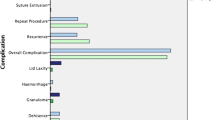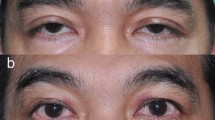Abstract
Purpose
Conjunctival chemosis is a common, usually benign, complication of ocular and oculoplastic surgery. After enucleation, evisceration, or secondary ball implant, however, conjunctival edema can cause conformer extrusion, forniceal eversion, and shortening which may complicate the future fitting of a prosthesis. This longitudinal chart review aimed to estimate the efficacy of a temporary suture tarsorrhaphy to minimize postoperative edema and improve conformer retention.
Methods
We retrospectively reviewed the charts of 415 consecutive patients undergoing enucleation, evisceration, and secondary ball implantation between 1990 and 2016. Three-hundred twenty-eight patients had complete data which was analyzed for age, gender, surgical details, complications, and follow-up.
Results
We identified 328 eyes that underwent enucleation (48%), evisceration (3%), or secondary implantation (49%) during the study period. Eighty-nine patients had a suture tarsorrhaphy at the time of surgery, and 239 did not. There was a statistically significant incidence of postoperative conjunctival edema in the no tarsorrhaphy group. There was also a significantly increased rate of conformer loss associated with conjunctival edema. Need for further surgery was not uncommon with 64% and 43% of patients requiring a secondary procedure in the no tarsorrhaphy and tarsorrhaphy groups respectively.
Conclusions
Temporary suture tarsorrhaphy is a simple and effective procedure that reduces conjunctival edema and increases conformer stability when performed at the time of enucleation, evisceration, or secondary ball implantation.

Similar content being viewed by others
References
Moshfeghi DM, Moshfeghi AA, Finger PT (2000) Enucleation. Surv Ophthalmol 44(4):277–301
Meltzer MA (1992) Complications of enucleation and evisceration: prevention and treatment. Int Ophthalmol Clin 32(4):213–233
Malone TJ, Tse DT (1990) Surgical treatment of chemotic conjunctival prolapse following vitreoretinal surgery. Arch Ophthalmol 108(6):890–891
Jordan D, Klapper S (2012) Enucleation, evisceration, secondary orbital implantation. In: Black E, Nesi F, Clavano C et al (eds) Smith and Nesi’s ophthalmic plastic and reconstructive surgery, 3rd edn. Springer, New York, pp 1105–1131
Walter WL (1985) Update on enucleation and evisceration surgery. Ophthal Plast Reconstr Surg 1(4):243–252
Quaranta-Leoni FM, Sposato S, Lorenzano D (2015) Secondary orbital ball implants after enucleation and evisceration: surgical management, morbidity, and long-term outcome. Ophthal Plast Reconstr Surg 31(2):115–118
Kostick DA, Linberg JV (1995) Evisceration with hydroxyapatite implant. Surgical technique and review of 31 case reports. Ophthalmology 102(10):1542–1548 discussion 48–9
Wang JK, Liao SL, Lai PC et al (2007) Prevention of exposure of porous orbital implants following enucleation. Am J Ophthalmol 143(1):61–67
Kaltreider SA, Lucarelli MJ (2002) A simple algorithm for selection of implant size for enucleation and evisceration: a prospective study. Ophthal Plast Reconstr Surg 18(5):336–341
Mules PH (1885) Evisceration of the globe with artificial vitreous. Trans Ophthalmic Soc UK 5:200
Rapoza PA, Harrison DA, Bussa JJ et al (1993) Temporary sutured tube-tarsorrhaphy: reversible eyelid closure technique. Ophthalmic Surg 24(5):328–330
Thaller VT, Vahdani K (2016) Tarsal suture tarsorrhaphy: quick, safe and effective corneal protection. Orbit 35(6):299–304
Custer PL, McCaffery S (2006) Complications of sclera-covered enucleation implants. Ophthal Plast Reconstr Surg 22(4):269–273
Brown SI (1969) An improved tarsorrhaphy technique and its therapeutic applications. Arch Ophthalmol 81(5):710–711
Fox SA (1961) A new tarsorrhaphy suture. Arch Ophthalmol 66:833–834
Sundelin KC, Dafgard Kopp EME (2015) Complications associated with secondary orbital implantations. Arch Ophthalmol 93:679–683
Author information
Authors and Affiliations
Corresponding author
Ethics declarations
Conflict of interest
The authors declare that they have no conflict of interest.
Ethical approval
All procedures performed in this study were in accordance with the ethical standards of the institutional research committee and with the 1964 Helsinki declaration and its later amendments. Given this was a retrospective study, formal consent was not required.
Rights and permissions
About this article
Cite this article
McGrath, L.A., McNab, A.A. Temporary suture tarsorrhaphy at the time of orbital ball implantation. Graefes Arch Clin Exp Ophthalmol 256, 2437–2441 (2018). https://doi.org/10.1007/s00417-018-4090-x
Received:
Revised:
Accepted:
Published:
Issue Date:
DOI: https://doi.org/10.1007/s00417-018-4090-x




